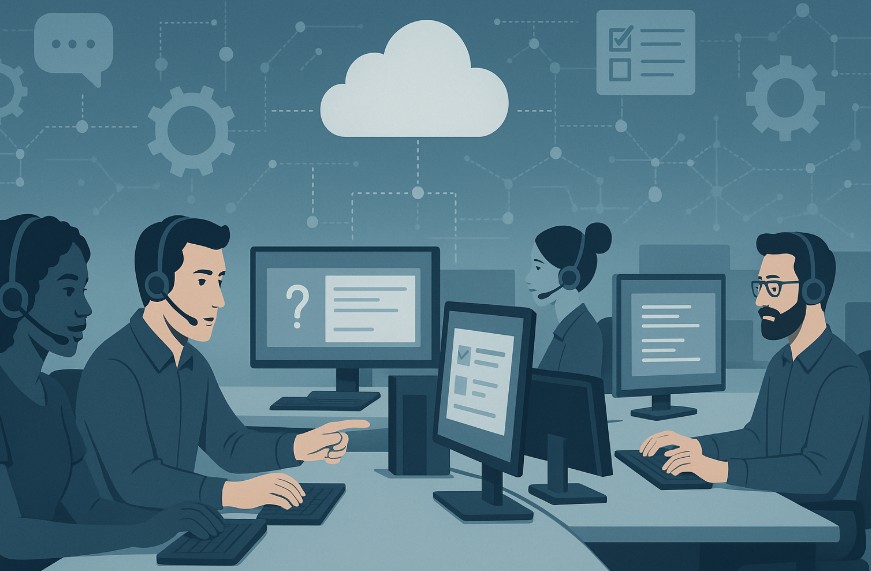
How does a business maintain seamless technology operations while juggling employee needs and customer demands? Who ensures that minor technical glitches don’t snowball into major disruptions? The answer lies with a crucial but often underappreciated team — the IT helpdesk.
The primary function of an IT helpdesk is to serve as the first point of contact for employees or customers facing technical issues. It provides immediate assistance, tracks and resolves incidents, manages service requests, and ensures minimal disruption to daily operations. Whether it’s helping with password resets or escalating a serious server outage, the IT helpdesk acts as a centralised support system to maintain operational efficiency.
In an era where technology is central to almost every business function, understanding the role, structure, and value of an IT helpdesk is essential for long-term success.
What Are the Main Functions of an IT Helpdesk?
An IT helpdesk does far more than answer support calls. It delivers structured support through a set of defined functions designed to address user needs, maintain IT systems, and align with business continuity goals.
Incident Management
Incident management involves identifying, logging, and resolving IT-related issues. These may range from software malfunctions to network failures or application errors. The helpdesk must not only fix the immediate problem but also document the incident for future reference and analysis.
Service Request Management
Not all support tasks are about fixing problems. Employees often request assistance with setting up new hardware, gaining access to internal platforms, or installing software. Service request management ensures these non-urgent, routine tasks are handled promptly and professionally.
Problem Resolution and Escalation
If an issue cannot be resolved at the first level, it must be escalated to specialised teams. The helpdesk acts as the gateway for this process, assessing the severity and complexity of the problem before forwarding it to the appropriate personnel.
Communication and User Updates
Throughout the resolution process, helpdesk teams must communicate clearly and consistently with users. This includes status updates, estimated resolution times, and explanations of the issue, ensuring users feel informed and supported.
Knowledge Base and Self-Service Support
Many IT helpdesks maintain a knowledge base of commonly encountered issues and solutions. This allows users to resolve minor problems independently and reduces the number of incoming tickets, helping the team focus on more critical tasks.
Why Is an IT Helpdesk Critical to Business Success?

An IT helpdesk isn’t just a technical support function, it’s a vital part of business infrastructure. It plays a significant role in:
- Enhancing productivity by ensuring staff can work with minimal interruptions.
- Improving customer service by addressing user concerns quickly.
- Supporting business growth by scaling alongside the organisation.
- Reducing operational risks by promptly addressing and documenting IT faults.
Without an efficient helpdesk, even small issues can create major setbacks. Prolonged downtime, for instance, may delay customer interactions, affect revenue, and damage brand reputation. The helpdesk acts as a frontline defence against such disruptions.
How Do Helpdesks Differ from Service Desks?
Though often used interchangeably, helpdesks and service desks have distinct roles within an organisation.
| Feature | Helpdesk | Service Desk |
| Primary Function | Incident resolution and user support | Holistic IT service delivery and management |
| Reactive vs Proactive | Mainly reactive | Both reactive and proactive |
| ITSM Alignment | Optional | Typically aligned with ITSM frameworks |
| Scope | Limited to immediate user issues | Broad, including change and asset management |
| User Base | Internal employees or external customers | Organisation-wide services |
Helpdesks are typically the entry-level support function, while service desks offer a broader scope aligned with ITIL and long-term service strategies.
Who Uses the IT Helpdesk and For What Purpose?
The helpdesk serves both internal staff and external customers, depending on the business model.
- Employees reach out for technical assistance with workplace systems, device configuration, connectivity issues, or service access.
- Customers may contact the helpdesk for product support, setup guidance, or bug resolution.
In some cases, even non-IT departments such as Human Resources or Finance operate their own helpdesks to streamline internal queries and support requests.
What Types of IT Helpdesks Exist?

Helpdesks can be structured in various ways to suit different operational demands. Understanding these types helps businesses choose the right model.
| Type | Description |
| Web/Cloud Helpdesk | Hosted online, accessible from any device with an internet connection. Suitable for remote and hybrid teams. |
| On-Site Helpdesk | Physical presence within company premises. Useful for hands-on support like hardware setup and repairs. |
| Enterprise Helpdesk | Built for large organisations with complex needs. Offers advanced features like AI, analytics, and integrations. |
| Open-Source Helpdesk | Customisable software with no licensing costs. Best for tech-savvy organisations with specific requirements. |
| Business Function Helpdesk | Operated by departments like HR or legal to address non-technical but essential queries. |
What Features Make a Helpdesk Effective?
To function effectively, a helpdesk must have more than just people and phones. It requires a strong technical foundation and strategic management.
Smart Ticketing Systems
Support tickets document user queries, allowing teams to track progress, assign responsibilities, and manage workloads. A robust ticketing system ensures requests are prioritised and resolved efficiently.
AI and Automation
Modern helpdesks often incorporate AI chatbots and automated workflows. These systems can handle routine queries, route tickets, and even provide 24/7 support, greatly increasing response times and consistency.
Performance Metrics and Reporting
Using analytics, managers can measure response times, user satisfaction, ticket volumes, and agent productivity. This data is invaluable for continuous improvement and strategic decision-making.
Self-Service Capabilities
Many users prefer to solve problems themselves. Helpdesks that provide access to FAQs, forums, and knowledge bases empower users while reducing support loads.
Feedback and Quality Assurance
User feedback helps identify service gaps and training needs. Advanced helpdesk platforms even use sentiment analysis to detect satisfaction levels and flag potential issues before escalation.
How Are Helpdesk Teams Structured?
A typical helpdesk team comprises several key roles:
- Helpdesk Agents: The frontline support staff who respond to queries and resolve most first-level issues.
- Team Leads: Monitor agent performance, provide coaching, and ensure adherence to SLAs (Service Level Agreements).
- Helpdesk Managers: Oversee staffing, performance reporting, process optimisation, and stakeholder communication.
Some organisations also include specialists for handling advanced issues or dedicated roles for knowledge management.
What Should You Consider When Choosing Helpdesk Software?
Selecting the right helpdesk solution depends on the size and complexity of your operations. Here are a few considerations:
| Factor | What to Look For |
| Ease of Use | A straightforward setup process and intuitive interface |
| Integration Capability | Ability to connect with existing tools like CRM, HR systems, and email platforms |
| Automation Features | Workflow automation, chatbot integration, ticket categorisation |
| Remote Accessibility | Cloud-based support for remote and hybrid teams |
| Scalability | Flexibility to handle growing ticket volumes and expanding user base |
| Customisation | Branding options, role-based access, and workflow tailoring |
Popular helpdesk platforms include Zendesk, Freshdesk, Jira Service Management, and ManageEngine.
How Much Does Helpdesk Software Typically Cost?
Pricing models for helpdesk software vary based on features, users, and deployment type.
| Tier | Price Range (Per Agent/Month) | Features Included |
| Free | £0 | Basic ticketing, limited users |
| Standard | £20 – £50 | Automation, analytics, multi-channel support |
| Enterprise | £50 – £200+ | Advanced security, AI, deep integrations, custom SLAs |
It’s advisable to trial software first to ensure it meets business requirements before committing to a plan.
How Does the IT Helpdesk Enhance Customer and Employee Experience?

Helpdesks significantly improve both customer satisfaction (CX) and employee experience (EX). By delivering reliable and timely support, they:
- Reduce frustration and increase user confidence
- Shorten downtime for technical issues
- Provide consistent communication during issue resolution
- Build trust and long-term loyalty
An effective helpdesk isn’t just a support function; it’s a reflection of the company’s commitment to operational excellence and user satisfaction.
Frequently Asked Questions
How does a helpdesk differ from technical support?
A helpdesk handles a wide range of support tasks, including ticketing and self-service support, while technical support usually focuses on in-depth issue resolution.
Is a helpdesk only for IT issues?
Not necessarily. Many businesses run departmental helpdesks for HR, finance, and legal inquiries.
Can small businesses benefit from helpdesks?
Yes. Even small teams gain efficiency by implementing basic helpdesk software for tracking and resolving support issues.
How do SLAs improve helpdesk performance?
Service Level Agreements define response and resolution timeframes, ensuring consistent performance and accountability.
Do helpdesks work 24/7?
Some do, especially in industries like healthcare or finance. AI bots and remote access tools support round-the-clock operations.
How can helpdesks support hybrid or remote teams?
Cloud-based helpdesks allow users and agents to connect from anywhere, maintaining continuity regardless of location.
What metrics should helpdesk managers track?
Key metrics include average resolution time, first-response time, ticket volume, customer satisfaction scores, and agent productivity.